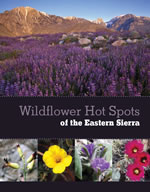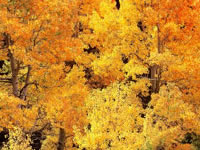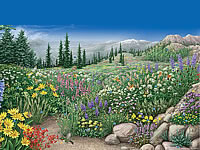Intermountain Region
 Intermountain Region. From “Guide to Your National Forests and Grasslands (PDF)”, 2006.
Intermountain Region. From “Guide to Your National Forests and Grasslands (PDF)”, 2006.
The Intermountain Region encompasses nearly 34 million acres of National Forest System lands (the largest in the nation). The Region covers 13 National Forests and one National Grassland within Utah, Nevada, western Wyoming, southern Idaho, and a small portion of California. Four major geographic provinces come together to form the Intermountain West: the Great Basin, Colorado Plateau, Middle Rocky Mountains, and Northern Rocky Mountains.
The richness of native species and high level of endemism of its flora can be explained by the extraordinary diversity of habitats, climatic conditions, unique geology, and isolation. Our wildflower viewing sites will take you from Red-rock deserts, to lush forested meadows, to the unsurpassed flower-gems of the Alpine tundra.
News
Researchers find an unusual hybrid origin in a rare plant

A colorful wildflower called Christ's paintbrush (Castilleja christii) is found only one place in the world, atop a southern Idaho mountain in an area only slightly larger than the Boise State University campus. Botanists first began noticing plants that did not seem to be typical Christ's paintbrush a number of years ago. Now, Boise State University graduate student Danielle Clay has found that the species developed from an unusual type of hybrid cross between two common species of paintbrush. (Idaho Native Plant Society's Sage Notes, December 2011, Volume 33(4).)
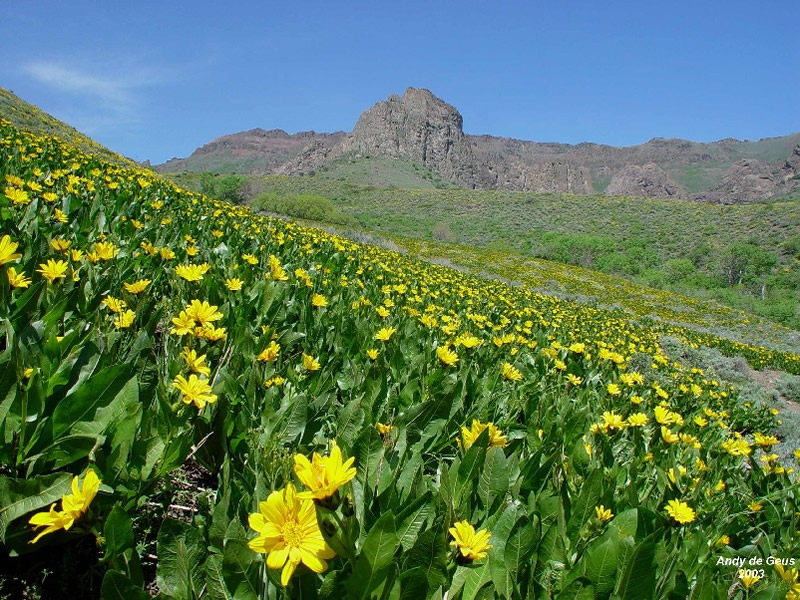 A profusion of Mule's ears (Wyethia amplexicaulis) blooming in Nevada's Humboldt-Toiyabe National Forest. Photo by Andy DeGeus.
A profusion of Mule's ears (Wyethia amplexicaulis) blooming in Nevada's Humboldt-Toiyabe National Forest. Photo by Andy DeGeus.
 Lupine, buckwheat, lomatiums, and other wildflowers carpet the trail to Ben Lomond Peak on the Wasatch-Cache National Forest, Utah. Photo by Teresa Prendusi.
Lupine, buckwheat, lomatiums, and other wildflowers carpet the trail to Ben Lomond Peak on the Wasatch-Cache National Forest, Utah. Photo by Teresa Prendusi.
 The stunning Island Lake landscape in Wyoming's Wind River mountains on the Bridger-Teton National Forest. Photo by Scott Clemons.
The stunning Island Lake landscape in Wyoming's Wind River mountains on the Bridger-Teton National Forest. Photo by Scott Clemons.
Botrychium Treasure Hunts
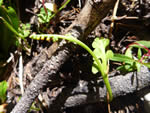
On August 6 and August 20, 2011, members of the Nevada Native Plant Society visited two spring sites in the Spring Mountains, Clark County, Nevada, to search for and, hopefully, learn how to identify Botrychium species. Botrychiums, also known as moonworts, belong to the Ophioglossaceae, an ancient family of plants distantly related to modern ferns.
Read more about Botrychium Treasure Hunts…
Rare Plant Conservation Success Stories
- Rare Plants and Alpine Vegetation of the La Sal Mountains: Studies of a Unique Ecosystem Rising Above the Arid Colorado Plateau Desert
- Uinta National Forest Introduction Program to Recover Clay Phacelia, Phacelia argillacea, One of Utah’s Most Endangered Species
Regional Information
Wildflower Hot Spots of the Eastern Sierra (PDF, 4.7 MB) Wildflower Hot Spots of the Eastern Sierra highlights the unique ecology, geology, and unparalleled flora along 150 miles of the Eastern Sierra corridor. Twelve wildflower sites have been selected to represent the diversity of environments that are found throughout the Eastern Sierra. Each site features directions, a map, GPS coordinates, a description of the natural history of the area, and photos. Topics you can learn about include plant rarity, disturbance processes, and the many ways people use plants. "Can You Find…?" proposes a fun challenge for you and your family. For a more in-depth look at the species found at each site, use the plant list featured in the back of this guide. Take the time to stop and smell the flowers in this extraordinary Eastern Sierra region!
Forest Visitor Guides
The Intermountain Region is compiling information and creating visitor guides for each of its forests. These guides will provide recreation information, history, a basic map and other valuable information. Visit the Intermountain Region's Forest Visitor Guides…
You Are There!
Explore a special place on our national forests and grasslands, Hike the Highline Trail…
Also See…
Fading Gold: The Decline of Aspen in the West
Fading Gold explores the aspen community in the western United States. It describes how aspen grows, the decline of aspen from in the Rocky Mountains to the Sierra Nevada Mountains, and the challenges for aspen in the western landscape. We feature aspen's beautiful fall colors, wildflowers in the aspen community, and the traces left in the aspen groves by past visitors.
Tall Forb Community of the Intermountain West
Few landscapes can match the beauty and profusion of wildflowers found in the lush, subalpine mountain parklands of the interior western States. Among the most unexpected and rarest of the high elevation plant communities is one dominated solely by large, luxuriant wildflowers, commonly referred to as the Tall Forb Community type.
Visit “Beauty of It All” for a closer look at the beautiful wildflowers of our national forests and grasslands …
Wildflower Photographs

Jacob's Ladder and Lupine in Albion Basin, Utah. Wasatch-Cache National Forest. Photo by Teresa Prendusi.

Western Columbine (Aquilegia formosa) and swallowtail butterfly (Papilio rutulus). Humboldt- Toiyabe National Forest. Photo by Marnie Bonesteel.

Prickly poppy (Argemone corymbosa). Manti-LaSal National Forest. Photo by Teresa Prendusi.

Scarlet milkvetch (Astragalus coccineus). Humboldt-Toiyabe NF. Photo by Janel Johnson.

Wildflowers (Lupine, Little sunflower, and Buckwheat) along Ben Lomond Peak Trail. Wasatch-Cache NF. Photo by Teresa Prendusi.

Leather flower (Clematis hirsutissima). Uinta National Forest. Photo by Teresa Prendusi.

A mountain field of Glacier Lilies (Erythronium grandiflorum) on the Uinta National Forest. Photo by Doug Page.

Green gentian (Frasera speciosa) on Bridger-Teton National Forest. Photo by Teresa Prendusi.

Wonderland Alice-flower (Aliciella caespitosa). Fishlake National Forest. Photo by Teresa Prendusi.

Sand cholla (Opuntia pulchella). Humboldt-Toiyabe NF. Photo by Janel Johnson.

Silky phacelia (Phacelia sericea). Uinta National Forest. Photo by Teresa Prendusi.

Opal phlox (Phlox opalensis). Ashley National Forest. Photo by Charmaine Delmatier.

Rough mules-ears (Wyethia scabra) Manti-LaSal National Forest. Photo by Teresa Prendusi.


